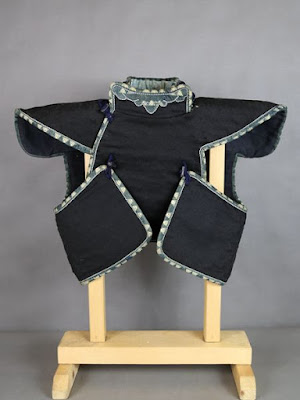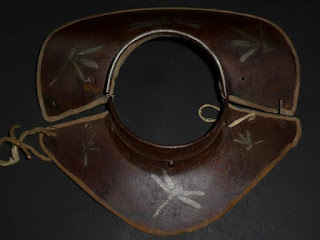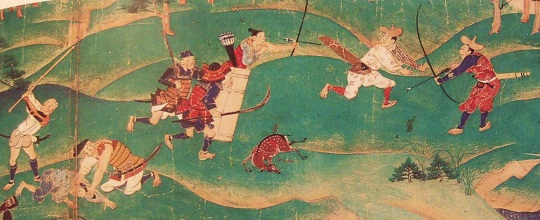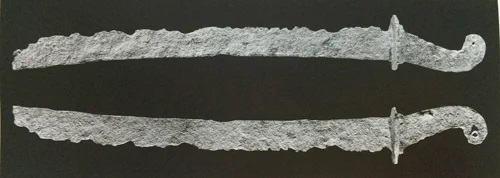Manchira (満智羅) - Japanese Auxiliary Armor
Manchira (満智羅) - Japanese Auxiliary Armor
A section taken by the 島原の乱図屏風 showing a warrior wearing a manchira.
The manchira (which can also be written 満智羅, 満散,満乳羅 or 摩牟知羅), also known as manjūwa (饅頭輪), mantōwa (満頭輪) or kataōi (肩被) is essentially an armored vest that was used either as a standalone armor or as a form of chest protector to be worn under or over the main breastplate, the dō (胴).
A sketch made by me showing cuirass plus manchira configuration.
For those who are familiar with European armor, this item functioned both as a form of arming doublets with integrated voiders or as a form of "mail" shirt.
As I've written in my detailed analysis of tōsei gusoku (当世具足) armor, this piece of equipment was actually used to cover the gaps that might be left uncovered by the main solid and rigid armor pieces.
The lack of this item in many armors of the period has created the myth that Japanese armor was somewhat open in vital spots (like the frontal armpit, the armpits or the side of the throat).
However, the manchira was one of the main piece mentioned in the Tanki Yoriaku Hi Ko Ben - 単騎被甲辨, a later Edo period book on how 16th century warriors shall be armed.
A type of manchira (more often than not called manju no wa in this configuration) from the 単騎被甲辨.
The idea of covering gaps in Japanese armor development could be reliably dated back to the early 14th century, where we can read through the Taiheiki (太平記) that mail shirt and voiders were used to cover the armpits and other areas left unprotected by the main suits of the period.
This might be explained that the latest encounter with the Yuan army and the turmoils of the late 13th and early to mid 14th century lead Japanese warfare to be much more focused on close quarter combat than before.
A type of manchira with both kikko and mail armor.
Dr. Y. Sasama in his works states that the manchira was a development that has to find its root in the European influences of the 16th century ( Nanban trade - 南蛮).
While it's true that European influences on period's armor shouldn't be overlooked, I beg to differ with Dr. Sasama in this matter.
As we can read through the Taiheiki, the whole concept of using auxiliary armor wasn't new to the Japanese, and similar proto-manchira in the form of mail shirt were actually worn already by the 14th century.
Moreover, a similar but less comprehensive armor compoment used to cover specifically the armpit gap, the wakibiki, was already in used as well before the Nanban trade.
A vest-like type of manchira.
So I don't think there are enough reasons to believe that the European kickstarted the development of such piece, but rather that the distinctive look of some types of manchira were indeed based on the clothes of the Europeans of the time.
In fact while more austere and practical manchira existed, some were arguably akin to sleveless shirt and often sported a ruff collar which testify the influence of European fashion.
In fact, around this period, wearing exotic armor pieces was indeed a fashion statement that has its own specific tradition.
This might also explain the fact that the word itself - manchira, sounds like the Spanish word mantilla, which was a type of garments worn by the first European that arrived in Japan. If anything, it was definitely a fashion influence rather than a practical one.
A classic type of manchira to be worn in conjuction with a breastplate. The armor is hidden between textile layers
A type of manchira with both kikko and mail armor.
Dr. Y. Sasama in his works states that the manchira was a development that has to find its root in the European influences of the 16th century ( Nanban trade - 南蛮).
While it's true that European influences on period's armor shouldn't be overlooked, I beg to differ with Dr. Sasama in this matter.
As we can read through the Taiheiki, the whole concept of using auxiliary armor wasn't new to the Japanese, and similar proto-manchira in the form of mail shirt were actually worn already by the 14th century.
Moreover, a similar but less comprehensive armor compoment used to cover specifically the armpit gap, the wakibiki, was already in used as well before the Nanban trade.
A vest-like type of manchira.
So I don't think there are enough reasons to believe that the European kickstarted the development of such piece, but rather that the distinctive look of some types of manchira were indeed based on the clothes of the Europeans of the time.
In fact while more austere and practical manchira existed, some were arguably akin to sleveless shirt and often sported a ruff collar which testify the influence of European fashion.
In fact, around this period, wearing exotic armor pieces was indeed a fashion statement that has its own specific tradition.
This might also explain the fact that the word itself - manchira, sounds like the Spanish word mantilla, which was a type of garments worn by the first European that arrived in Japan. If anything, it was definitely a fashion influence rather than a practical one.
A classic type of manchira to be worn in conjuction with a breastplate. The armor is hidden between textile layers
There are essentially two types of manchira; one that works as auxiliary armor, so it is shorter and usually only cover the gaps of the armor (these version is frequently called manju no wa), although shirt-like versions should belong to this category as well, and one that is intended to be worn as a standalone armor, easy to conceal under ordinary clothes, so it is longer and usually covers the entire torso.
A manchira becames an armored katabira if sleeves are included: in fact, the former usually only covers the upper shoulder rather than the entire arms.
There is also another types of manchira which is rather unique - the nanban manchira (南蛮満智羅), which essentially consist of European inspired gorget to be worn over the cuirass.
A rather simple and small nanban manchira.
Given the fact that it was supposed to be flexible in order to fit under the armor, the manchira was usually made of kikkōgane, hexagonal plates, karutagane connected with mail, mail (kusari - 鎖) or a combination of both. More often than not it was slightly padded and covered with silks or textile which was decorated and embellished, especially when it was supposed to be worn alone.
It has been discussed quite a lot if the type 1 was meant to be worn under or over the cuirass and the actual consesus is that both interpretation were used by the warriors of the period.
Moreover, during the Azuchi-momoyama period a kote with an integrated manchira-like collar was developed, the so-called Tominaga-sashinuki-gote (富永指貫籠手).
Occasionally, the manchira and back part was split again and equipped with hooks and toggles and an additional cord. This allowed the wearer a better adjustment of the kote by the same protection and he was also able to wear only one part. In order to make a putting on faster and easier, the toggles were usually pre-connected.
Thank you for the reading and your attention, I hope this article was an informative one! Please feel free to leave a comment and share the article.
A standalone type manchira armor.
It has been discussed quite a lot if the type 1 was meant to be worn under or over the cuirass and the actual consesus is that both interpretation were used by the warriors of the period.
Moreover, during the Azuchi-momoyama period a kote with an integrated manchira-like collar was developed, the so-called Tominaga-sashinuki-gote (富永指貫籠手).
Occasionally, the manchira and back part was split again and equipped with hooks and toggles and an additional cord. This allowed the wearer a better adjustment of the kote by the same protection and he was also able to wear only one part. In order to make a putting on faster and easier, the toggles were usually pre-connected.
Tominaga gote with integrated manchira.
Thank you for the reading and your attention, I hope this article was an informative one! Please feel free to leave a comment and share the article.
Gunbai
















Thanks again for an interesting article. Any insight into how the trend shifted to tate eri late?
ReplyDeleteI'd be curious to see how manchira would be worn over armor. Obviously it would have to be sized differently to fit over the dō, and there might be issue with arrow and spear tips becoming entangled rather than slipping off. Would make an interesting experiment.
Thank you!
DeleteThe tate eri was actually an independent development after the introduction of iron wadagami, so that there was a need of softer padding under that section of the armor. Then it evolved in the padded collar and shoulder section. It was also more common to see that on armor designed to not be worn with a manchira because that will be a little bit redundant, but you can still fit other auxiliary armor components like the wakibiki.
Here there is an example of a reenactor wearing a manchira over a dō:
https://pbs.twimg.com/media/ELa5QKnUwAAPmUY?format=jpg&name=4096x4096
Nice article.
ReplyDeleteI think the Manchira armpit armor work differently than a Wakibiki because it has Kikko construction, I think it will bend over when the wearer move his upper arm down and it will spring back up when he lift the upper arm.
I don't think that the Manchira is even European influenced. The old Kote design already have parts that extent to cover the torso, maybe the Japanese just separate the arm and the torso part to make the arm part easier to be worn or discard.
The more I look into manchira example the more I think that it wasn' really designed to protect the armpit itself but the lateral area around it that was still left exposed a little bit by the cuirass. In fact the best way to protect that area would be having an integrated wakibiki with the kote.
DeleteI think the same about the European influence, it might have some relevance when it comes to some design which were not seen before in Japanese garments, like the sleeveless vest, but it wasn't definitely the starting point of such armor.
The area of the upper arm-armpit-shoulder joint is one of the hardest to armor.
DeleteActually when seeing the Manchira, Wakibiki and Kote, I want to know why the Japanese didn't just make Manchira with Kikko or plated mail short sleeve to completely cover that area.
They could also add armor in the old Kote design.
With Wakibiki, some design already have have front plate that cover the area that was covered by the Besagew.
I personally think the Manchira did not really add any more covering, just another layer.
Various Do design already have integrated Kikko collar and parts that jut sideward from shoulder straps. The front of the joint could be protected with Gyoyo or Wakibiki.
I guess because they didn't want too many armor in that spot, probably but it's only a guess.
DeleteOne hypothesis that explain why the manchira was created (especially the vest-like version) is that it was supposed to be worn in conjuction with a hara-ate, so that it can give you a lighter protection on the back if needed. But still I think it does a good job at protecting the area and it's definitely faster to wear especially with the integrated kote configuration.
Yes, I agree it could be a simpler way to cover the gaps that could be worn quicker.
DeleteMaybe it could be interesting as well if you make an article why Kikko are invented and constructed in such form.
I still couldn't get over how many problem could be solved if the Japanese reuse that Kofun lamellar sleeve and just remake into a short manchira with sleeve.
That will remove the problem of having to make different part of armor to cover the gaps and I think it is more sturdy than the Kikko construction of the Manchira.
Or just add armor like plated mail, Kikko or laminar plates to body part of the old kote.
They already cover a lot of exposed areas.
https://upload.wikimedia.org/wikipedia/commons/c/c9/Gosannen_kassen_ekotoba_-_Scroll_3_part_2.jpg
https://upload.wikimedia.org/wikipedia/commons/8/86/Gosannen_kassen_ekotoba_-_Scroll_3_part_7.jpg
https://upload.wikimedia.org/wikipedia/commons/0/03/Gosannen_kassen_ekotoba_-_Scroll_2_part_12.jpg
I believe that is what that is possibly worn in this scroll. I just see mail all along the inside of the arm until it reach the armpit.
https://www.metmuseum.org/art/collection/search/65122
LONG HAVE I AWAITED THIS MOMENT!
ReplyDeleteThe Manchira is such a little known and underappreciated piece of armor! I can't even seem to find much info on it in Japanese. It's so great to finally have someone give it due credit!
Thanks a lot!
DeleteIt is indeed such a shame that this very important piece of armor doesn't get the attention and the study it deserves.
I hope to have give it a least some justice!
I think you mentioned kusari katabira were also used acording to the heike monogatari, relatively early? What do you think might they have looked like ? Similiar to there edo period cousins ore different?
ReplyDeleteWe have evidence of Kusari being used to cover the arms and as a form of shikoro in the Kamakura period, and we could read of mail shirt being worn undern the main armor in the Taiheiki which is around the 14th century ( I guess that was the monogatari you were talking about, as there is no mention of such things in the Heike).
DeleteUnfortunately there are no depictions nor findings but we could assume that they wouldn't differ that much from their edo period version: after all it's a mail shirt in the Japanese fashion. But it might also be that those weren't full shirt but rather small pieces of mail sewn to the gaps.
Hello, Gunsen,
ReplyDeleteI just found a depiction of Japanese shield use and it seems that this one is before Edo Period.
https://pbs.twimg.com/media/EFZIgeRUUAAGcs9?format=jpg&name=large
https://i.pinimg.com/originals/2c/81/83/2c8183cd9bda005beead767ae404a2ba.jpg
The name of the scroll is Honen Kamijin Eden 法然上人絵伝 .
I don't know the exact period it is made. The combatant seems to be more heavily armored than normal Kamakura depiction, so maybe Nanbokucho Period?
Sorry, about the non-related topic, but I think this is quite interesting to discuss.
Don't worry! I was aware of the scroll (actually it's called Hounen Jounin Emaki) but I didn't know where to get a high quality full screen resolution picture and instead I made a sketch about that specific shield.
DeleteThe scroll is actually dated 13th century
Thank you for clarifying its period and its name. I think it show that kind of shield being used since Kamakura Period, so far the earliest personal shield that is not body length that I had seen is the buckler one from early 16th century.
DeleteI guess that creating an article about Japanese shield change from Kofun period to Kamakura period is even harder than making one about armor transition?
About the manchira, did the full length manchira worn beneath armor as well?
I mean this one
https://1.bp.blogspot.com/-l6mdXtuZhCw/Xid30-MrSXI/AAAAAAAABr4/LMVbe6ZBjFoO0VbPGfcJY0W_cJiISYD-wCLcBGAsYHQ/s1600/98bc220c60c3630e6eedd360ff175501.jpg
instead of this
https://1.bp.blogspot.com/-cVDEycM2Qbo/Xid2vUWQMcI/AAAAAAAABrc/KCy4iPs2vdQV30kJuy7yAvFM2nUage5WwCLcBGAsYHQ/s1600/manchira%2B2.jpg
I find this picture about putting armor while wearing old style Kote. What is the small sleeve at the armpit? Is it old armpit armor before the Wakibiki?
Deletehttps://pbs.twimg.com/media/DTRY9TmU0AA3vfn?format=jpg&name=large
Maybe it is similar to the plate worn near the armpit.
https://livedoor.blogimg.jp/sky_defence-muromachi/imgs/6/f/6f8cc1e8.jpg
I'm pretty sure that all the information that we have about Japanese shields is already covered in my article; but if I'll find more I will edit it for sure! But yes pretty much all we know about shields in Japan during the Kamakura period are these extremely few depictions.
DeleteI'm quite sure that big manchira were not meant to be worn under armor unless you were wearing only a hara ate. They are more akin to later kusari katabira in terms of function.
Also I'm quite sure that that depiction of wearing armor is one of the several edition of the same book, published in the Edo period, the tanki yoriaku hi ko ben.
Althought it might look like a older style of armor, it is definitely a tosei gusoku with kebiki odoshi and I think that the armor depicted there is a manchira indeed, since it has both a shoulder piece as well as the under arm part. So yes I would say it is a manchira